I am pleased to report that digital astrophotography is not the bear that many people have lead me to believe. Like conventional film astrophotography, there will be disappointments, but the basics are pretty similar. Don't let the disappointments get you down, they are necessary for learning.
The following is a pretty basic guideline for how I image with my Canon XS DSLR.
1. Use a high ISO setting, at least in the beginning, like 800 or 1600. Aim your camera at the target. Make sure the camera is set in RAW + JPEG mode. I use a timer to control mine but you can use a laptop. I prefer the timer.
2. Use a good lens (the kit lens in my case), make sure your focus is good. Focusing is perhaps the hardest part of the whole operation.
3. Expose for a few minutes (I use 3 now) on a stable vibration free platform. You can shoot several exposures of the same length (and should). The more the better.
4. Your stable platform should be a good quality and well aligned mount, in my case, the LXD75 with the SN6 on it, camera riding on a bracket on the back. Your image is as good as your ability to keep it stable and tracking properly for the exposure duration. I view my object directly in my scope to check tracking.
4. Shoot a number of exposures on targets of the same length, use 2 or 3 minutes as a good starter. Cover the lens or whatever the camera is hooked to and shoot an equal number of dark frames of equal time which are used for subtracting the thermal noise from the images using software. Do this when you are done imaging what you want.
5. Load all the frames of your target object (lights and darks)in Deep Sky Stacker, stack them. DSS is a simple software package to use. Use the default settings, dig into the manual and online information for more help.
5. Take the final image and adjust it to your liking. I've recently began using PhotoShop and it makes it very simple to achieve pleasing results. PhotoShop is a world of its own, but it's basics have really helped me a lot.
This simple process will yield satisfying results, or at least it has for me.
About 4 weeks into this process, I am getting decent enough results to use as a basis for the hard part, which is working to achieve exceptional results. This is where it gets into precise polar alignment, much longer exposures, many more frames, learning how to use autoguiding, and learning a whole lot about post-processing. Start simple so you are not compounding your mistakes and wasting a lot of time making them.
I am amazed that I have gotten this far, and if I can do it, you can as well.
Saturday, November 28, 2009
Sunday, November 22, 2009
Constellation Imaging
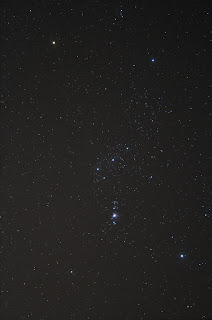
I had to give this a shot to see how it would look, so I centered the scope on Orion and shot a sequence of 10 shots of Orion at 3 minutes, 55mm at f/5.6 and ISO 1600, and then selected the best 5 images to stack with Deep Sky Stacker for a total of 15 minutes of integration time. I've been advancing with my processing technique's having finally learned how to adjust some of the levels and obtain decent contrast and color, and this is evident in the results with Betelgeuse (upper left) and Rigel (lower right) showing some proper colors. In the larger image there is some red nebulosity visible in M42, the center star in the sword of Orion, although, as expected, the whole nebula is a little "blown out." This one has been a good learning experience and demonstrates some progress in what I am learning.
Friday, November 20, 2009
A Dazzling Trio
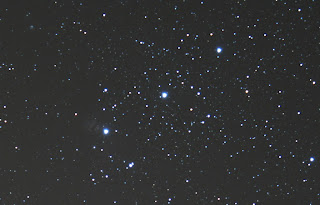
The 3 belt stars in the constellation of Orion are perhaps one of the most recognized asterisms in the Winter sky. Many people are drawn to these 3 beauties almost immediately. Let's take a closer look at these 3 stars.
From left to right, the stars are named Alnitak, Alnilam, and Mintaka, and they are some of the brightest and hottest stars in the sky.
Alnitak is a triple star system, about 800 light years distant, and is sometimes referred to as Zeta Orionis, and the primary star is a class O type blue supergiant. In fact it is the brightest star of it's class visible in our night sky. It is 28 times more massive than our sun, and over 20 times larger. It's companion, Alnitak B is a B type star and orbits the primary once every 1500 years. Alnitak Ab, the third star is also an O type star and was only recently discovered. Nearby this star system is the flame nebula and the horesehead nebula.
Alnilam lies at a distance of 1000 light years and is referred to as Epsilon Orionis. It is a B type blue-white supergiant, and in spite of its farther distance than the other two, is actually the most powerful visible bright star in the sky. This star stands to turn into a red supergiant in about a million years and stands an excellent chance of becoming a supernova.
Mintaka is the right most star in the belt, and is also known as Delta Orionis. It is a multiple star system with a class B giant as the primary and a smaller but hotter class O as a secondary. The stars move very rapidly, orbiting each other about once every 5.7 days. One can only imagine the chaos in this region, some 900 light years distant.
So while we look at this configuration calmly and as a place of great beauty, it is one of the most cataclysmic regions in the heavens, both a stellar nursery and a graveyard, somewhere out on a spiral arm in our own Milky Way galaxy.
Monday, November 16, 2009
The Fair, The Bad, and The Ugly
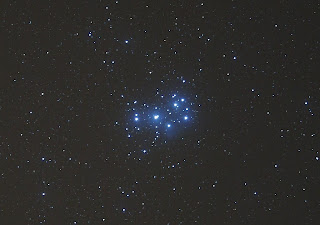
I was pleased with the results of M45, 20 frames at 3 minutes each, ISO 800 at 55mm, f/5.6, the sky background came out reasonably clean, there is decent nebulosity, and the framing was about right. I had an enlargement made of this one and it looks good.
.JPG)
My M42 was imaged with 20 frames at 3 minutes each, ISO 800 at 55mm, f/5.6 as well, but I am displeased with the background on this one. I've tried processing it a couple of times, but I think the problems lies in my dark frames.
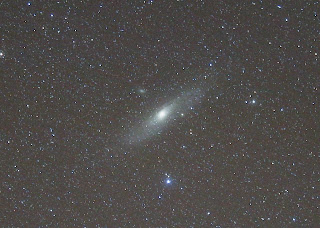
M31 is a nice target, but this photo does no justice to it. Shot 20 frames at 3 minutes each, ISO 800 at 55mm, f/5.6 and using the same dark frames as used with M42 above, this was very well placed in the sky, the night was perfectly clear with excellent seeing so I can't blame it on anything like that.
With practice, all of this will improve.
Friday, November 13, 2009
A Much Needed Accessory
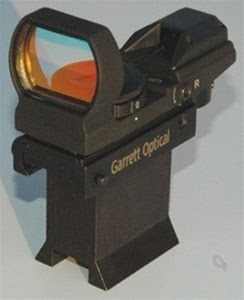
These little multi-target red dot finders are one of the most useful items I have found. So far I have purchased two of them, one for my binocular mount, and one for my telescope. Using them to sight a guide star is very useful in the dark when a crosshair is invisible.
So tonight I came up with a great idea. Someone should build an adapter to allow mounting one of these on the accessory shoe of a camera. This would greatly assist in sighting the camera when fastening it piggyback style on a telescope, simply because using the optical camera sight is near impossible and it is an inconvenience to align it.
Other applications that could be developed for this base would include a replacement dovetail that would fit the base for both Meade and Celestron telescopes. I consider these little items to be among the most valuable convenience items one can have while working in the dark.
Sunday, November 8, 2009
Nights Like Tonight
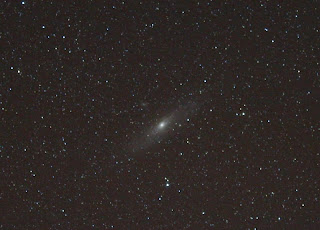.jpg)
I've waited all week for this evening, knowing that my clear sky clock was blue through and through. The moon and weather just right, I took the scope out at 4PM. I installed a battery in my homemade powertank, put my mount on the marks, powered it up, did a reset, calibration and train drives, mounted the DSLR piggyback, focused it on Jupiter using the live view, and set out with a pad of paper to do some imaging and viewing. I prepped a pot of chili in the crockpot (good warm up food), brewed a pot of coffee, took the heating pad and a deck chair outside, and at dark I ran my alignment routines and got busy grabbing images.
The first image (above) is M31, shot with 10 lights at 2 minutes, 10 darks, and using a 55mm focal length at f/5.6 ISO 800 - I cropped and resized this image to obtain the best looking scale I could, and did some minimal processing using the Digital Photo Professional software included with the Canon XS.
.jpg)
The second image is the Double Cluster in Perseus shot with all the same information as above, cropped slightly and resized for posting purposes.
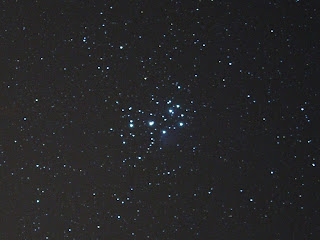
Finally I shot a sequence of photos of the Pleiades, again 20 minutes total exposure at f/5.6, 55mm, and I am completely shocked to see that it captured some of the region's blue nebulosity. This is one object that I will return to later and obtain much more frames just to see what I can do with it on a stock camera lens. Simply amazing to me.
It was really neat to sit back and watch it all work, scope performing flawlessly, a mix of viewing and imaging, all the electronics in action, everything doing well as planned, the perfect harmony of technology and beauty in action. I am so pleased with the way this all works and it's not an accident, it is exactly what I wanted and demonstrates the results of my grand plan. I refuse to become equipment laden and top heavy. I know what I like, I know what I don't want, and often simplicity and functionality trump everything, especially on a cold evening of astronomy. It has all come together, and I love it.
Friday, November 6, 2009
A Visit to Barren Fork Campground
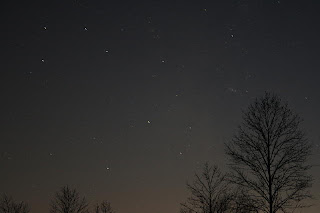
I've waited all week to spend a little time at my favorite campground and check out the darkness of this place for camera work, and tonight I was not disappointed with the sky at all. Considering that the moon is less than ideal for astronomy tonight, this site really is wonderful because you can see the dust lanes in the milky way galaxy, M31 easily with the naked eye, even the North America nebula. In fact, it's hard to pick out the constellations, but fortunately I was raised on skys like this so for me, it's like going home, and it reminds me in a very humbling way why I really love the stars, and why I crave the absence of light pollution. Barren Fork campground is a primitive campground nestled in the heart of the Daniel Boone National Forest, and it's only about 10 minutes from home.
The image above is the teapot of Sagittarius, setting at the end of twilight. It is a single 30 second exposure shot at 55mm f/5.6, one dark frame subtracted in Deep Sky Stacker. I'd really like to get shots like this on my LXD75 equatorial mount to remove the trailing and so that I can add some density to my imaging, and if all goes well, tommorow evening will be my first attempts at doing just that when I piggyback my camera and go for it.
Tuesday, November 3, 2009
Taming the Kitty Cat
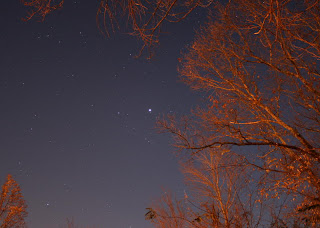
After much anticipation I decided to try my hand at using my new Canon XS for some fixed tripod shots to learn how to use some of the camera and remote control features. I've had it for a few days and I've read the manual a bit, and last night I figured out how to set the exposure, ISO, turn on the live view and run the timer, so earlier this evening, under a full moon sky I shot ten 30 second shots of Jupiter with the lens set at f/4.0, 18mm focal length, ISO 800 to capture the image above, which was a simple JPEG. I have done no processing, just cropped it a bit to remove the house from the image. I shot these in RAW + JPEG, and I also shot 10 darks in the same format so I can play around with it a bit with some stacking software and see what results.
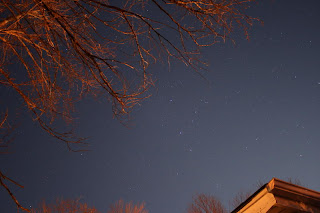
The second image is the constellation of Cassiopeia shot using the same settings with no cropping performed, however the moon was well up by now and lighting up the sky pretty well. It did give me a chance to see what to expect as far as focusing and using the live view feature and magnification to obtain focus. In the original images at full size you can see a bit of trailing on the stars, and on the image of Jupiter with some magnification you can even see one of the moons. I believe this will work very well piggybacking on the SN6 when I finally get the chance to test this under a good dark sky. That opportunity may come as early as this weekend.
Sunday, November 1, 2009
The Equipment Myth
There was a time a few years back when I had a very nice roll off roof observatory with a 10 inch equatorial mounted Cave telescope all set up for dual axis control and off axis guiding, with an 80mm f/4 piggybacked refractor. My observatory was equipped with a heater, variable red lighting, and doubled as a darkroom for processing film and printing images. I had a modern 35mm SLR equipped with all the goodies at this time. I spent many hours under the night sky in my observatory doing both visual and photographic astronomy, using a star atlas and a list of objects that I wanted to target. This was so long ago that using a computer was not even really an option, except to print lists of objects with their co-ordinates on a dot matrix printer. I shot plenty of film with that setup using Ektachrome 800, Fuji 400, Konica 1600, gas hypered Tech Pan 2415, and Kodak spectroscopic film. I thought I had the ultimate setup. You can see it in the photo at the top of my blog.
But years before this there was a time when my primitive gear included an old 35mm camera that my uncle had given me. The lens on this camera could not be removed, and the shutter on it was broken. You could cap the lens, load film in the camera, click to advance frames, etc, but the shutter would not close. I was 14 years old at the time, but I didn't let that stop me from enjoying it. I fixed it to a home made mounting, waited for a dark sky, and carefully removed the lens cap, each exposure carefully targeted. My darkroom consisted of an old kitchen that was completely dark but had running water, where I carefully developed the film in a tray in the dark using chemicals that I had mixed before. My telescope for visual usage at that time consisted of a 6 inch f/8 on a home made mount with no clock drive, a pier with a vacuum cleaner pipe stuffed with a wooden dowel, and a base from an old canister vacuum. I also had a 50mm alt-azimuth mounted "Sears special" refractor. And a star atlas, a notepad, and a red flashlight.
So here I am tonite, taking stock of where I am at, and I can't help but reflect on what an amazing thing this is. I just purchased my first DSLR, the Canon XS, for doing digital astrophotography, along with a T adapter for doing prime focus. I have my Meade 6 inch Schmidt Newtonian mounted on the LXD75 AutoStar equipped GoTo equatorial mount. I have a custom made accessory bracket on my tube cradle where I can mount my camera for tracked piggybacking, or another refractor. Sitting on the Orion Paragon HDF2 tripod next to this gear is my 15x70 astro binoculars. A quick release shoe removes them from the tripod and my camera snaps in place, and I am looking at this thinking how cool this is to have this little setup with so much flexibility. In my eyes, I have never had a setup that I like so much. But it strikes me that I am using a setup very similar to what I was using at 14 years of age, except that the technology of it all has improved everything immensely. I no longer have to mess with chemicals. I see the results of my images in minutes instead of hours. I tell the telescope where to point. The exposure time and information is controlled electronically. I can piggyback with the scope and view with the binoculars. Or I can do wide field tripod mounted imaging and view with the scope. It's light enough to go with me so I am not fixed in one spot. And my laptop is connected via wireless to the Internet and loaded with plenty of software to help me under the night sky.
Correct me if I am wrong, but isn't this where I started?
But years before this there was a time when my primitive gear included an old 35mm camera that my uncle had given me. The lens on this camera could not be removed, and the shutter on it was broken. You could cap the lens, load film in the camera, click to advance frames, etc, but the shutter would not close. I was 14 years old at the time, but I didn't let that stop me from enjoying it. I fixed it to a home made mounting, waited for a dark sky, and carefully removed the lens cap, each exposure carefully targeted. My darkroom consisted of an old kitchen that was completely dark but had running water, where I carefully developed the film in a tray in the dark using chemicals that I had mixed before. My telescope for visual usage at that time consisted of a 6 inch f/8 on a home made mount with no clock drive, a pier with a vacuum cleaner pipe stuffed with a wooden dowel, and a base from an old canister vacuum. I also had a 50mm alt-azimuth mounted "Sears special" refractor. And a star atlas, a notepad, and a red flashlight.
So here I am tonite, taking stock of where I am at, and I can't help but reflect on what an amazing thing this is. I just purchased my first DSLR, the Canon XS, for doing digital astrophotography, along with a T adapter for doing prime focus. I have my Meade 6 inch Schmidt Newtonian mounted on the LXD75 AutoStar equipped GoTo equatorial mount. I have a custom made accessory bracket on my tube cradle where I can mount my camera for tracked piggybacking, or another refractor. Sitting on the Orion Paragon HDF2 tripod next to this gear is my 15x70 astro binoculars. A quick release shoe removes them from the tripod and my camera snaps in place, and I am looking at this thinking how cool this is to have this little setup with so much flexibility. In my eyes, I have never had a setup that I like so much. But it strikes me that I am using a setup very similar to what I was using at 14 years of age, except that the technology of it all has improved everything immensely. I no longer have to mess with chemicals. I see the results of my images in minutes instead of hours. I tell the telescope where to point. The exposure time and information is controlled electronically. I can piggyback with the scope and view with the binoculars. Or I can do wide field tripod mounted imaging and view with the scope. It's light enough to go with me so I am not fixed in one spot. And my laptop is connected via wireless to the Internet and loaded with plenty of software to help me under the night sky.
Correct me if I am wrong, but isn't this where I started?
Subscribe to:
Posts (Atom)

